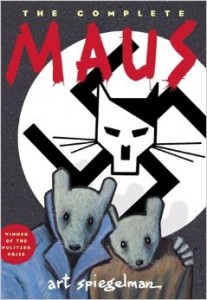Hi guys!
So this week in ASTU we were still pretty focused on the graphic memoir Persepolis, and an article about it called “The texture of of retracing in Marjane Satrapi’s ‘Persepolis'” by Hillary Chute. But because I focused on Persepolis in my last blog post I thought I would write about something a bit different this week…
In our class lecture a few days ago Dr. Luger briefly mentioned one of my all time favorite books. It’s another wonderful graphic narrative called Maus (and it’s sequel Maus II of course) by Art Spiegelman, it’s an incredible (Pulitzer prize-winning) story about Spiegelman’s parents and how they survived the Holocaust, and I was really excited when it came up again in Chute’s article.
Though Chute was primarily writing about Persepolis and the power of Satrapi’s choice to tell her story as a graphic memoir, and she only mentioned Spiegelman’s work briefly along with a few other examples, I felt as though many of her main ideas applied very nicely to Maus as well. She explains that through her illustrations, Satrapi is able to show us the “practice” of remembering (97). She writes “She shows us, then, the visual and discursive process of ‘never forgetting'” (97). I believe that this is something that Maus is successful at as well, as it is also the recollection of war, and family, and survival told through the same medium through more than one perspective (his and his father’s).
Chute argues that Satrapi’s “monochromatic” (98) visuals bring more power to her story and they really portray depth or “thickness”(98) of her memories, and she quotes Satrapi on page 99 saying “To draw it and put it in color — the color of flesh and the red of the blood, and so forth — reduces it by making it realistic,” . I found this quote and Chute’s expansion on the idea applied to Maus so perfectly, because not only does he also take the black and white approach to his illustrations (though he uses lots of shading and doesn’t use as much flat black on pure white as Satrapi), he takes the idea of making the images less realistic even further by turning all of the characters into animals. He represents the Jews as mice, the Nazis as cats, the Americans as dogs, and so forth, taking these truly horrific human experiences and assigning them to creatures we can’t really relate to. I’ve always thought that this made the whole piece even more intriguing and powerful, and it’s so interesting to have the reasoning put into words so nicely.
If you haven’t read Maus I would highly recommend it! Seriously, you guys, it’s amazing.
Thanks for reading!
Olivea
